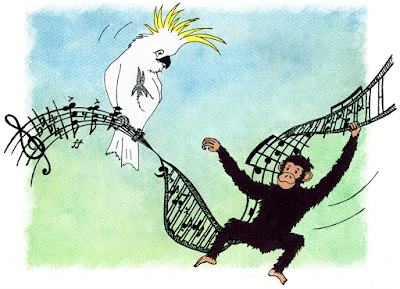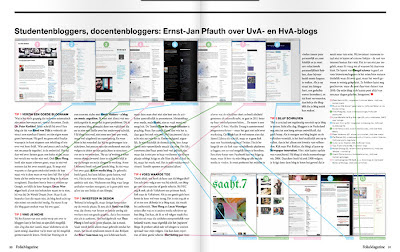Feel free to join the BètaBreak on June 20th between 12:00 and 13:30 at Science Park 904, Amsterdam, to explore the relationship between music and time in an interdisciplinary discussion with insights from biology, evolution, musicology and philosophy with speakers from the University of Amsterdam, the University of Liverpool and the University of Oslo!
Wednesday, June 18, 2025
What do Bach, bipedalism and a baby crying have in common?
Monday, May 19, 2025
Music in our genes?
 |
| © ILLC Blog, Illustration by Marianne de Heer Kloots |
"In 1984, a curious study on musicality in animals was published. The researchers from Portland, Oregon trained pigeons to distinguish two pieces of music – one by Bach, the other by Stravinsky. If the birds got it right, they were rewarded with food. Afterwards, the same pigeons were exposed to new pieces of music from the same composers. Surprisingly, they were still able to determine which piece was composed by which composer.This finding confronted researchers with a new set of questions. To what extent are animals musical? What does it even mean for an animal to be musical? And what can this teach us about musicality in humans?"
(From Music in our genes, ILLC Blog).
Thursday, April 24, 2025
What is the use of the comparative approach in studying the origins of language and music?
 |
| Diagrammatic
representation of the comparative approach (as discussed in ten Cate & Honing, 2022/2025) |
De Gregorio, C., Valente, D., Raimondi, T., Torti, V., Miaretsoa, L., Friard, O., Giacoma, C., Ravignani, A. & Gamba, M. (2021). Categorical rhythms in a singing primate. Current Biology, 31(20), R1379–R1380. https://doi.org/10.1016/j.cub.2021.09.032
Doolittle, E. L., Gingras, B., Endres, D. M. & Fitch, W. T. (2014). Overtone-based pitch selection in hermit thrush song: Unexpected convergence with scale construction in human music. Proceedings of the National Academy of Sciences, 11(46), 1–6. https://doi.org/10.1073/pnas.1406023111
Ten Cate, C. & & Honing, H. (2025). Precursors of Music and Language in Animals. Sammler, D.
(ed.) Oxford Handbook of Language and Music Oxford: Oxford University Press. DOI 10.1093/oxfordhb/9780192894700.013.0026. Preprint: psyarxiv.com/4zxtr.
Tuesday, April 01, 2025
Wetenschap in de blogosfeer? [Dutch]
"Ik weet niet direct wat muziekcognitie is, maar dat is geen probleem. Dit is een prima blog, gemaakt door een vakidioot die zo te zien met liefde over het onderwerp schrijft. Hij blogt niet veel, niet eens een keer per week, maar wel uitgebreid en nauwkeurig. En voor hem is het voordeel dat hij nu gedwongen is te schrijven, het proces van zijn onderzoek met zijn volgers te delen en zijn gedachten te structureren en te verwoorden."
Wednesday, November 06, 2024
Interested in a challenging postdoc position in Amsterdam?
 |
| MCG in November 2024. |
More information, including details on how to apply, will be made available soon at our website.
Deadline for applications : 1 December 2024.
Tuesday, October 22, 2024
Interested in doing a PhD in Music Cognition?
Master students of the UvA (or excellent external candidates) are invited to submit a short proposal to be selected as a candidate for NWO's PhD in the Humanities programme.
Sunday, September 29, 2024
Musical Animals: Are We? Can There Be?
 |
| Lecture at Barenboim-Said Akademie in 2016. |
I invited the attendees—many of whom were professional musicians and distinguished educators at the Barenboim-Said Academy—to envision themselves as expert judges on a conservatory selection committee. They were asked to assess the musicianship of an ensemble based solely on a brief excerpt of a live recording I played for them. Emulating the traditional audition process, where candidates perform behind a curtain to ensure impartiality, I asked the audience to make their judgments based solely on what they heard.
The audience's reaction was split; some were enthusiastic, while others were unimpressed. When asked for their thoughts, the positive responders praised the performance as experimental yet well-executed, whereas the negative ones criticized the timing as sloppy and the music as lacking melody. However, their opinions shifted dramatically after viewing a original video of the musicians: a group of Thai elephants, led by a human conductor, that were playing an array of percussion instruments and a mouth harmonica (see video registration).
This example is not just amusing; it also highlights some pitfalls in the study of the biology of music. Although I influenced the audience by framing the test as an audition, their varied reactions reveal more about human perception than about the elephants’ musical abilities. This raises a fundamental question: what must an organism—whether human, elephant, or bird—perceive to experience something as music? For instance, while the songs of an Amazonian songbird may sound musical to us, this perception reflects our own biases. To truly understand a bird's sense of musicality, we must ask whether the bird hears its own song as music. This inquiry shifts the attention from studying the structure of music to studying the structure of musicality.
Over the last two decades it has become evident that humans share a natural predisposition for music, akin to our inherent capacity for language (Hagoort, 2019). This predisposition, which I like to term musicality, encompasses a set of traits that develops spontaneously, is shaped by our cognitive abilities, as well being constrained by its underlying biology. Unlike music itself, which varies across cultures and societies, musicality refers to the cognitive and biological capacities that enable us to perceive and appreciate music, even among those who may not play an instrument or sing out of tune (Honing et al., 2015).
The shift in the study of the origins of music, from studying the structural aspects of music to trying to understand the structure of our capacity for music, marks an important change in perspective in music research, as reflected in the titles of two foundational meetings and their resulting publications: The Origins of Music (Wallin et al., 2000) and, consequently, The Origins of Musicality (Honing, 2018b). While the cross-cultural study of the structure of music (melodic patterns, scales, tonality, etc.) has offered exciting insights (Mehr et al., 2019; Savage et al., 2015), the approach used in these studies is indirect: the object of study here is music—the result of musicality—rather than musicality itself. Hence it is virtually impossible to distinguish between the individual contributions of culture and biology. For example, it is not clear whether the division of an octave into small and unequal intervals in a particular musical culture results from a widespread theoretical doctrine or from a music perception ability or a biological constrained predisposition.
All this is an important motivation to study the structure of musicality– i.e. the capacity for music–, its constituent components (see Table 1), and how these might be shared with other animals, aiming to disentangle the biological, cultural and environmental contributions to the human capacity for music. All these are topics that are elegantly addressed in the current volume.
[This text is a fragment of a preliminary version of an introductory chapter of The Biology of Music (Ravignani, in press)]
Ravignani, A. (ed.) (in press) The Biology of Music: Interdisciplinary Insights. Oxford: Oxford University Press.
Saturday, July 13, 2024
Do you know a parrot that talks or sings?
Saturday, June 15, 2024
Ben jij muzikaal? [Dutch]
Wednesday, June 12, 2024
Why do humans sing? |ヒトはなぜ歌うのか
Below a trailer of a Japanese documentary on the origins of musicality, made by NHK, entitled Why do humans sing? (ヒトはなぜ歌うのか ).
The one hour documentary presents cross-species and cross-cultural research on musicality, realized and filmed in Amsterdam, Inuyama, Boston and the rainforest of Central Africa.
For more information see NHK | Frontiers.





